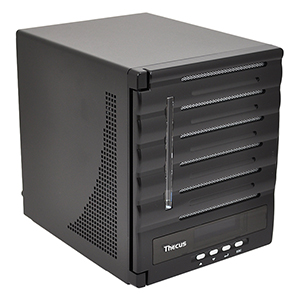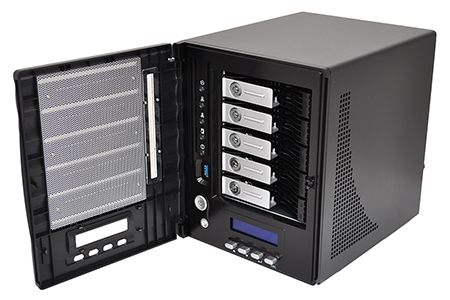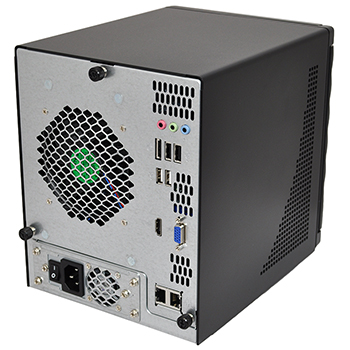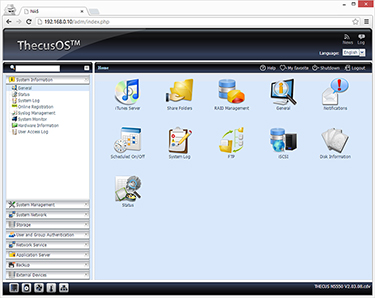Introduction
The N5550 is one of Thecus' latest five-bay NAS solutions, and in keeping with many of the company's earlier efforts, it promises a compelling blend of performance and functionality at a reasonable cost of £450.
Putting that price tag up against the other Taiwanese protagonists suggests that Thecus will continue to target the price-conscious consumer. Synology's five-bay unit (the DS1512+) will set you back some £630, while Qnap's five-bay TS-569L is available in the region of £570.
Value for money is clearly one of the N5550's key selling points, but Thecus' relatively-low price tags have historically been accompanied by minor product revisions and software that's occasionally rough around the edges. Is the N5550 any different? Well, at first glance perhaps not. The chassis, save for a Thecus badge on the front, is practically identical to that of the N5500 we reviewed back in 2009. That's a surprise, considering that the N5500's chassis was awfully similar to the N4100 from 2005.
Thecus is certainly one for familiarity, but as a consequence the N5550 is beginning to look a little monotonous, at least as far as NAS boxes are concerned. The front-facing LCD continues to provide rudimentary data on system status, the four menu navigation buttons remain crude, and the plastic door is little more than a hindrance - it feels fragile in comparison to the chassis' metal body and unnecessarily obscures the HDD status LEDs while restricting access to the power and reset buttons, as well as the front USB 3.0 port.
So little has changed externally that users need to look to the specification sheet for items that set the N5550 apart. And there are quite a few of them. Thecus has upgraded the CPU to a dual-core 1.86GHz Intel Atom D2550 and the accompanying memory is provided by a single stick of 2GB Transcend DDR3 memory.
Both the CPU and chipset are passively cooled, but Thecus does have two fans built into the N5550; one providing airflow to the hard-disk bays, the other in place to cool the integrated 200W PSU. Unfortunately, neither fan is particularly quiet and the NAS does put out a fair amount of noise - with five hard disks equipped it easily drowns out our PCs, so you wouldn't necessarily want it on the desk beside you.
A pair of Intel 82574L Gigabit Ethernet controllers are used to drive the unit's link aggregation capabilities, a Samsung NAND memory chip is used to store the operating system, and the front-facing SuperSpeed USB 3.0 port is powered by a third-party NEC controller. Thecus' choice of hardware is good and the combination of a dual-core Intel Atom processor and 2GB of DDR3 memory should deliver strong overall performance.
And the box isn't lacking in trimmings. All five pull-out drive trays are lockable and include mounting points for 2.5in or 2.5in drives, four USB 2.0 ports are found around back alongside an eSATA port, and Thecus has also hooked up a HDMI output. The latter is underutilised out of the box, but the addition of HDMI connectivity has potential and users can download and implement a third-party XBMC add-on module from the Thecus website.
Thecus' hardware is feature-packed yet perhaps lacking in overall refinement, and the same sentiment can be applied to the accompanying operating system. Although Thecus continues to roll out incremental updates - we're now at OS 5.0 - the company's interface looks and feels the same as it did a couple of years ago.
However, while not as attractive or forward-looking as some of the competition, Thecus's UI does offer a wealth of functionality that's presented in a two-pane interface - menus on the left, controls on the right - that feels familiar from the off. Getting up and running is simple enough, you can either type the IP address into your browser or use the available Thecus finder utility, and from here on in the configuration options are seemingly endless.
RAID modes 0, 1, 5, 6, 10 and JBOD are supported, with users having the option to create multiple RAID volumes, and Thecus offers a choice of XFS, EXT3 and EXT4 file systems. RAID migration, expansion and encryption are all readily available options, as is hot-swap functionality and automatic rebuild.
User groups and individual quotas are well managed, email notifications are easy to configure, a power schedule can be used to turn the device on and off on a daily schedule, backups are well catered for with local, remote and cloud options, and all the usual servers are in play - including media, iTunes, FTP and printer. To provide would-be customers with a full overview of what's available, Thecus has a live demo of OS 5.0 available at this URL.
A comprehensive feature set coupled with capable hardware and a relatively-low price tag should make the N5550 one of the most capable five-bay NAS solutions available for under £500. Let's put it to the test.















